Chronic Kidney Disease: A Case Study
VerifiedAdded on 2023/06/13
|12
|3166
|494
AI Summary
This paper discusses Chronic Kidney Disease (CKD) with reference to a case study of a patient, Glenda, who has the condition. The stages of CKD, the pathophysiology of CKD, management strategies and health promotion strategies will be analyzed. The approaches of care in Glenda’s case will be critiqued on basis of appropriateness and any recommendations or alternatives posed with support from recent literature and publication; an evidence-based approach.
Contribute Materials
Your contribution can guide someone’s learning journey. Share your
documents today.
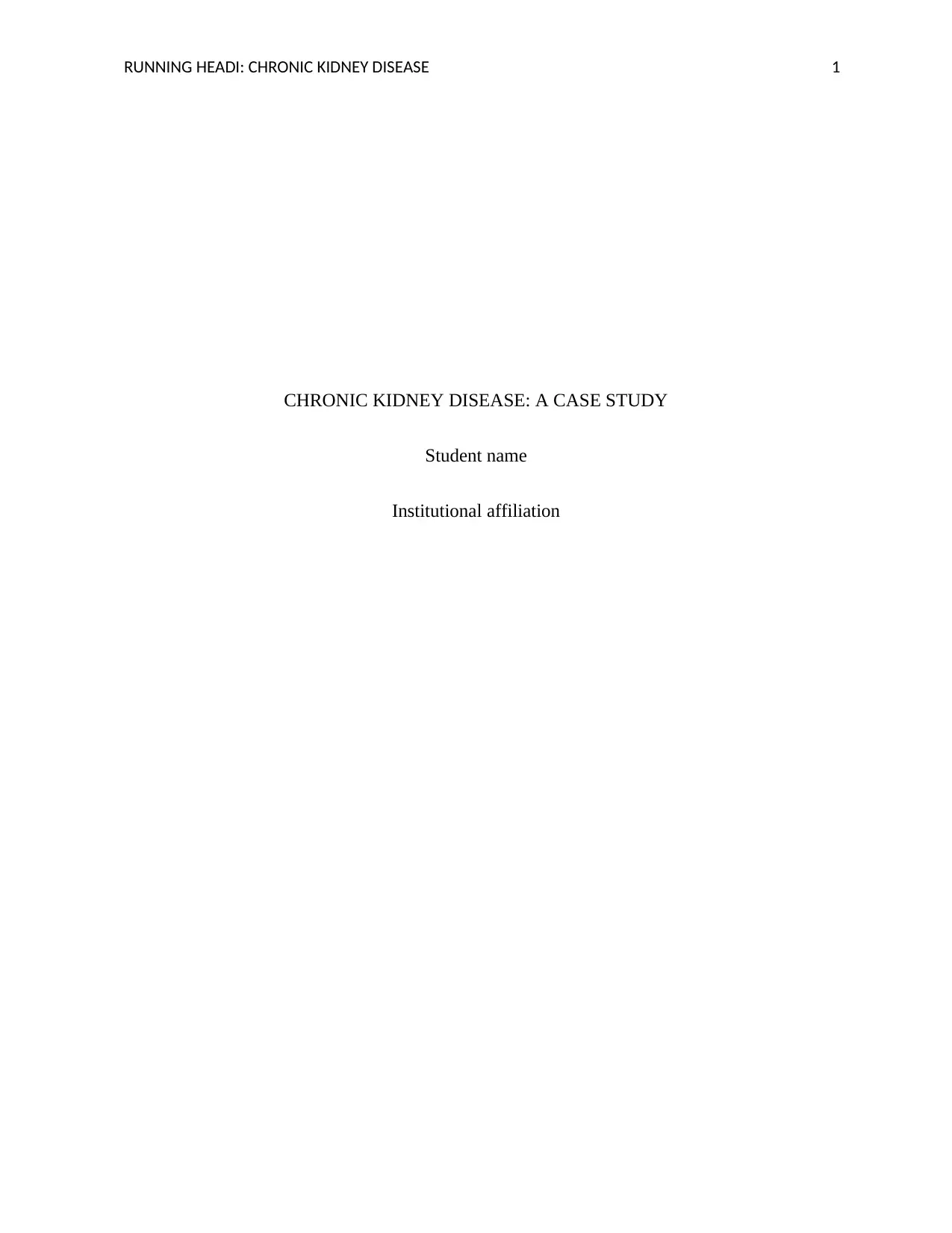
RUNNING HEADI: CHRONIC KIDNEY DISEASE 1
CHRONIC KIDNEY DISEASE: A CASE STUDY
Student name
Institutional affiliation
CHRONIC KIDNEY DISEASE: A CASE STUDY
Student name
Institutional affiliation
Secure Best Marks with AI Grader
Need help grading? Try our AI Grader for instant feedback on your assignments.
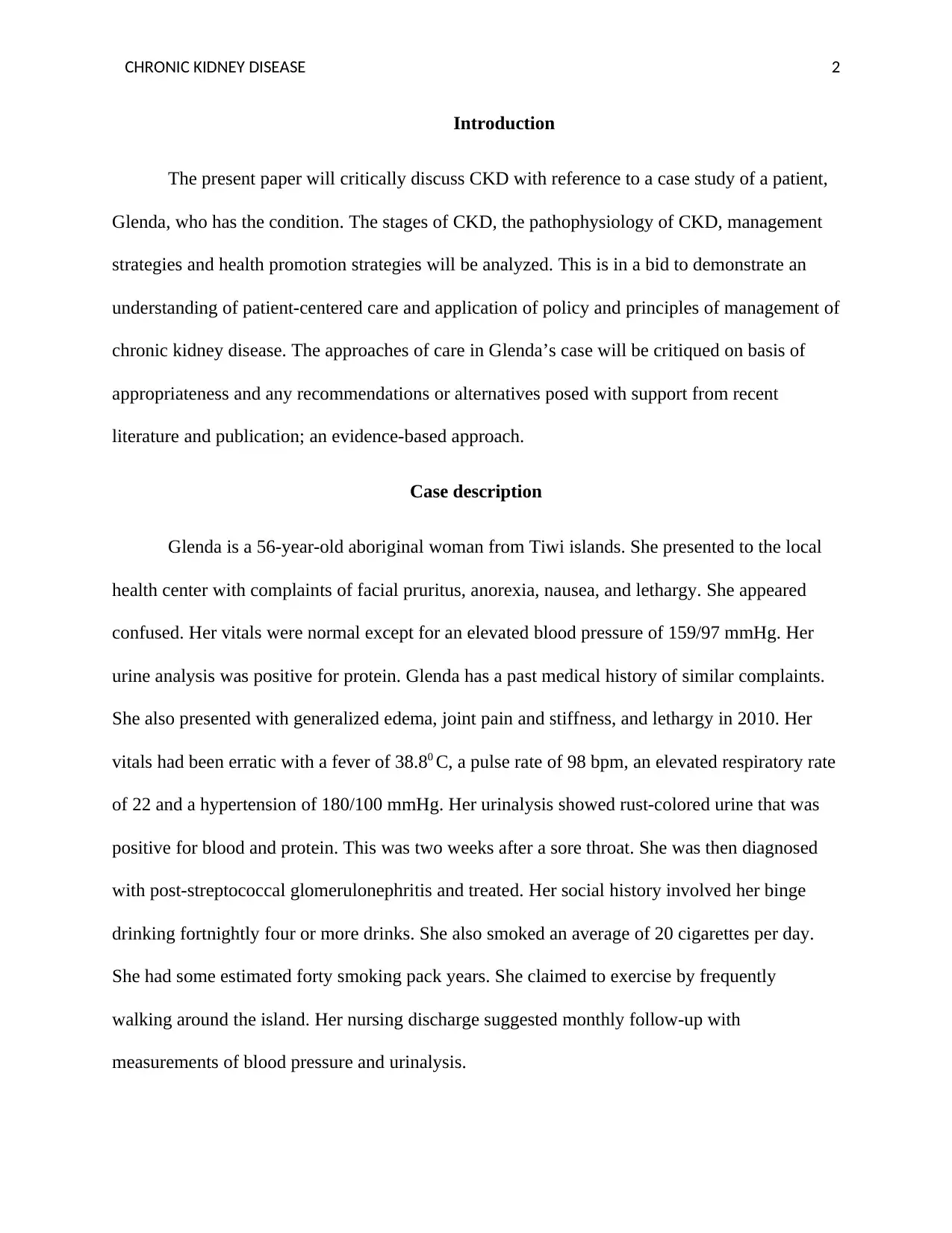
CHRONIC KIDNEY DISEASE 2
Introduction
The present paper will critically discuss CKD with reference to a case study of a patient,
Glenda, who has the condition. The stages of CKD, the pathophysiology of CKD, management
strategies and health promotion strategies will be analyzed. This is in a bid to demonstrate an
understanding of patient-centered care and application of policy and principles of management of
chronic kidney disease. The approaches of care in Glenda’s case will be critiqued on basis of
appropriateness and any recommendations or alternatives posed with support from recent
literature and publication; an evidence-based approach.
Case description
Glenda is a 56-year-old aboriginal woman from Tiwi islands. She presented to the local
health center with complaints of facial pruritus, anorexia, nausea, and lethargy. She appeared
confused. Her vitals were normal except for an elevated blood pressure of 159/97 mmHg. Her
urine analysis was positive for protein. Glenda has a past medical history of similar complaints.
She also presented with generalized edema, joint pain and stiffness, and lethargy in 2010. Her
vitals had been erratic with a fever of 38.80 C, a pulse rate of 98 bpm, an elevated respiratory rate
of 22 and a hypertension of 180/100 mmHg. Her urinalysis showed rust-colored urine that was
positive for blood and protein. This was two weeks after a sore throat. She was then diagnosed
with post-streptococcal glomerulonephritis and treated. Her social history involved her binge
drinking fortnightly four or more drinks. She also smoked an average of 20 cigarettes per day.
She had some estimated forty smoking pack years. She claimed to exercise by frequently
walking around the island. Her nursing discharge suggested monthly follow-up with
measurements of blood pressure and urinalysis.
Introduction
The present paper will critically discuss CKD with reference to a case study of a patient,
Glenda, who has the condition. The stages of CKD, the pathophysiology of CKD, management
strategies and health promotion strategies will be analyzed. This is in a bid to demonstrate an
understanding of patient-centered care and application of policy and principles of management of
chronic kidney disease. The approaches of care in Glenda’s case will be critiqued on basis of
appropriateness and any recommendations or alternatives posed with support from recent
literature and publication; an evidence-based approach.
Case description
Glenda is a 56-year-old aboriginal woman from Tiwi islands. She presented to the local
health center with complaints of facial pruritus, anorexia, nausea, and lethargy. She appeared
confused. Her vitals were normal except for an elevated blood pressure of 159/97 mmHg. Her
urine analysis was positive for protein. Glenda has a past medical history of similar complaints.
She also presented with generalized edema, joint pain and stiffness, and lethargy in 2010. Her
vitals had been erratic with a fever of 38.80 C, a pulse rate of 98 bpm, an elevated respiratory rate
of 22 and a hypertension of 180/100 mmHg. Her urinalysis showed rust-colored urine that was
positive for blood and protein. This was two weeks after a sore throat. She was then diagnosed
with post-streptococcal glomerulonephritis and treated. Her social history involved her binge
drinking fortnightly four or more drinks. She also smoked an average of 20 cigarettes per day.
She had some estimated forty smoking pack years. She claimed to exercise by frequently
walking around the island. Her nursing discharge suggested monthly follow-up with
measurements of blood pressure and urinalysis.
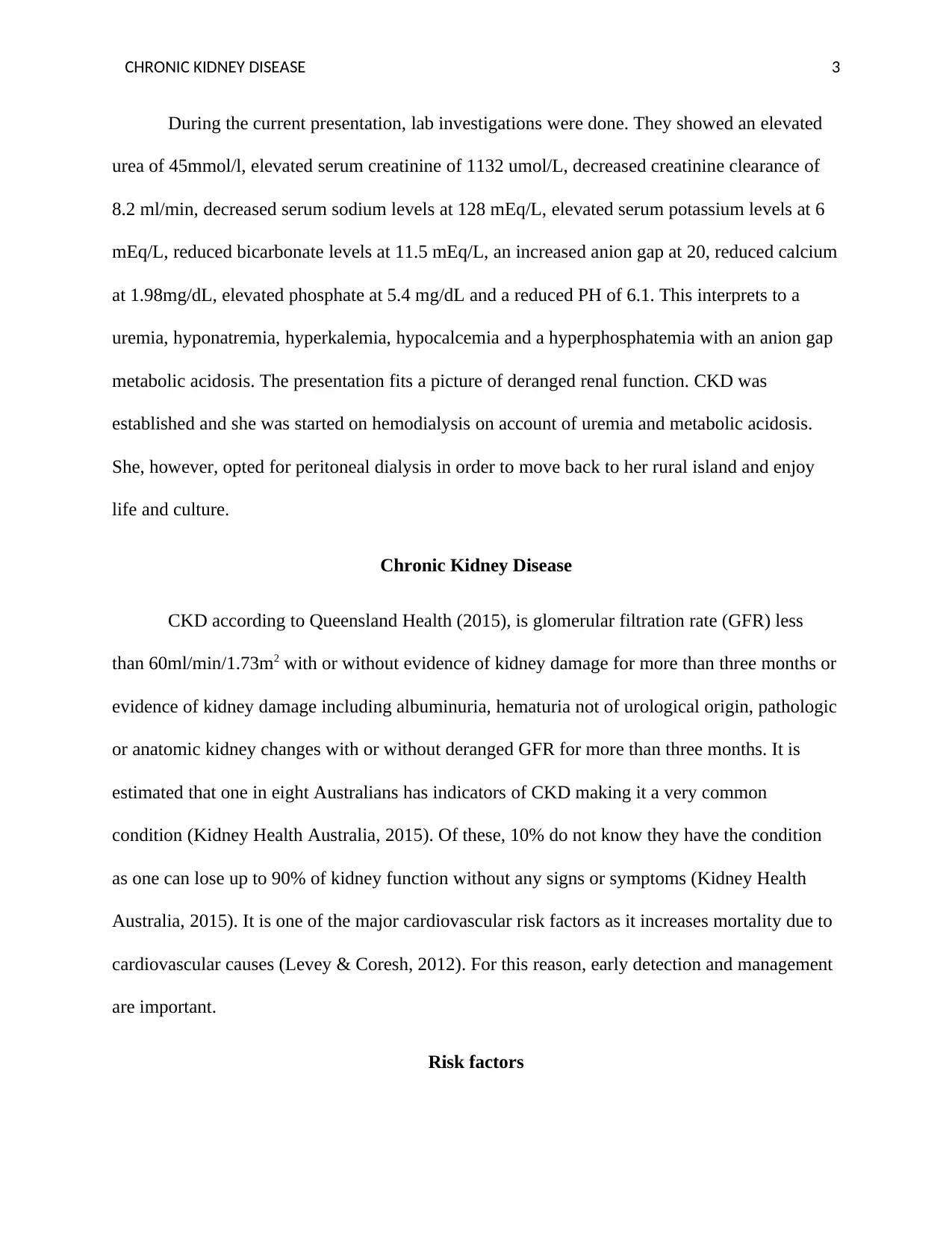
CHRONIC KIDNEY DISEASE 3
During the current presentation, lab investigations were done. They showed an elevated
urea of 45mmol/l, elevated serum creatinine of 1132 umol/L, decreased creatinine clearance of
8.2 ml/min, decreased serum sodium levels at 128 mEq/L, elevated serum potassium levels at 6
mEq/L, reduced bicarbonate levels at 11.5 mEq/L, an increased anion gap at 20, reduced calcium
at 1.98mg/dL, elevated phosphate at 5.4 mg/dL and a reduced PH of 6.1. This interprets to a
uremia, hyponatremia, hyperkalemia, hypocalcemia and a hyperphosphatemia with an anion gap
metabolic acidosis. The presentation fits a picture of deranged renal function. CKD was
established and she was started on hemodialysis on account of uremia and metabolic acidosis.
She, however, opted for peritoneal dialysis in order to move back to her rural island and enjoy
life and culture.
Chronic Kidney Disease
CKD according to Queensland Health (2015), is glomerular filtration rate (GFR) less
than 60ml/min/1.73m2 with or without evidence of kidney damage for more than three months or
evidence of kidney damage including albuminuria, hematuria not of urological origin, pathologic
or anatomic kidney changes with or without deranged GFR for more than three months. It is
estimated that one in eight Australians has indicators of CKD making it a very common
condition (Kidney Health Australia, 2015). Of these, 10% do not know they have the condition
as one can lose up to 90% of kidney function without any signs or symptoms (Kidney Health
Australia, 2015). It is one of the major cardiovascular risk factors as it increases mortality due to
cardiovascular causes (Levey & Coresh, 2012). For this reason, early detection and management
are important.
Risk factors
During the current presentation, lab investigations were done. They showed an elevated
urea of 45mmol/l, elevated serum creatinine of 1132 umol/L, decreased creatinine clearance of
8.2 ml/min, decreased serum sodium levels at 128 mEq/L, elevated serum potassium levels at 6
mEq/L, reduced bicarbonate levels at 11.5 mEq/L, an increased anion gap at 20, reduced calcium
at 1.98mg/dL, elevated phosphate at 5.4 mg/dL and a reduced PH of 6.1. This interprets to a
uremia, hyponatremia, hyperkalemia, hypocalcemia and a hyperphosphatemia with an anion gap
metabolic acidosis. The presentation fits a picture of deranged renal function. CKD was
established and she was started on hemodialysis on account of uremia and metabolic acidosis.
She, however, opted for peritoneal dialysis in order to move back to her rural island and enjoy
life and culture.
Chronic Kidney Disease
CKD according to Queensland Health (2015), is glomerular filtration rate (GFR) less
than 60ml/min/1.73m2 with or without evidence of kidney damage for more than three months or
evidence of kidney damage including albuminuria, hematuria not of urological origin, pathologic
or anatomic kidney changes with or without deranged GFR for more than three months. It is
estimated that one in eight Australians has indicators of CKD making it a very common
condition (Kidney Health Australia, 2015). Of these, 10% do not know they have the condition
as one can lose up to 90% of kidney function without any signs or symptoms (Kidney Health
Australia, 2015). It is one of the major cardiovascular risk factors as it increases mortality due to
cardiovascular causes (Levey & Coresh, 2012). For this reason, early detection and management
are important.
Risk factors
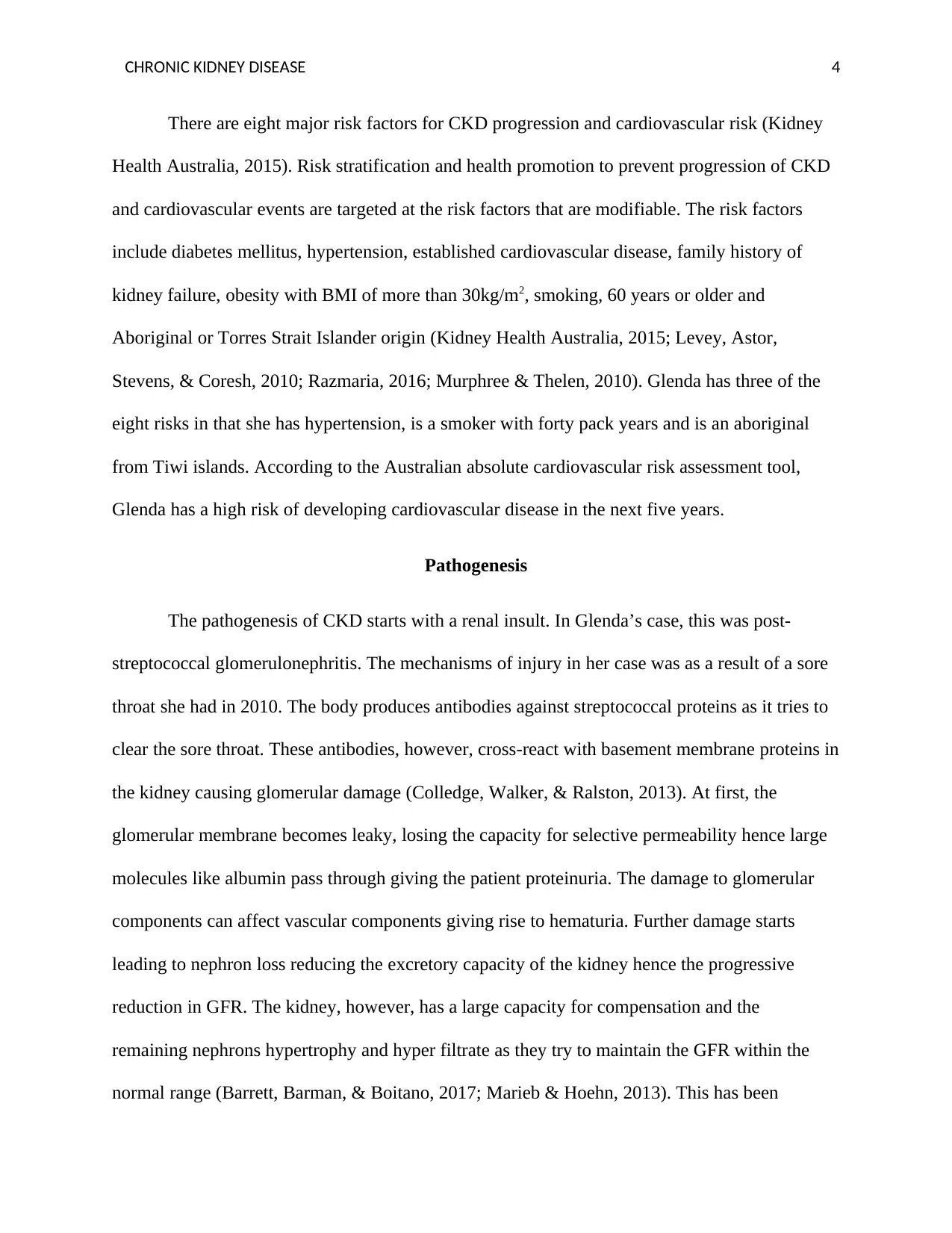
CHRONIC KIDNEY DISEASE 4
There are eight major risk factors for CKD progression and cardiovascular risk (Kidney
Health Australia, 2015). Risk stratification and health promotion to prevent progression of CKD
and cardiovascular events are targeted at the risk factors that are modifiable. The risk factors
include diabetes mellitus, hypertension, established cardiovascular disease, family history of
kidney failure, obesity with BMI of more than 30kg/m2, smoking, 60 years or older and
Aboriginal or Torres Strait Islander origin (Kidney Health Australia, 2015; Levey, Astor,
Stevens, & Coresh, 2010; Razmaria, 2016; Murphree & Thelen, 2010). Glenda has three of the
eight risks in that she has hypertension, is a smoker with forty pack years and is an aboriginal
from Tiwi islands. According to the Australian absolute cardiovascular risk assessment tool,
Glenda has a high risk of developing cardiovascular disease in the next five years.
Pathogenesis
The pathogenesis of CKD starts with a renal insult. In Glenda’s case, this was post-
streptococcal glomerulonephritis. The mechanisms of injury in her case was as a result of a sore
throat she had in 2010. The body produces antibodies against streptococcal proteins as it tries to
clear the sore throat. These antibodies, however, cross-react with basement membrane proteins in
the kidney causing glomerular damage (Colledge, Walker, & Ralston, 2013). At first, the
glomerular membrane becomes leaky, losing the capacity for selective permeability hence large
molecules like albumin pass through giving the patient proteinuria. The damage to glomerular
components can affect vascular components giving rise to hematuria. Further damage starts
leading to nephron loss reducing the excretory capacity of the kidney hence the progressive
reduction in GFR. The kidney, however, has a large capacity for compensation and the
remaining nephrons hypertrophy and hyper filtrate as they try to maintain the GFR within the
normal range (Barrett, Barman, & Boitano, 2017; Marieb & Hoehn, 2013). This has been
There are eight major risk factors for CKD progression and cardiovascular risk (Kidney
Health Australia, 2015). Risk stratification and health promotion to prevent progression of CKD
and cardiovascular events are targeted at the risk factors that are modifiable. The risk factors
include diabetes mellitus, hypertension, established cardiovascular disease, family history of
kidney failure, obesity with BMI of more than 30kg/m2, smoking, 60 years or older and
Aboriginal or Torres Strait Islander origin (Kidney Health Australia, 2015; Levey, Astor,
Stevens, & Coresh, 2010; Razmaria, 2016; Murphree & Thelen, 2010). Glenda has three of the
eight risks in that she has hypertension, is a smoker with forty pack years and is an aboriginal
from Tiwi islands. According to the Australian absolute cardiovascular risk assessment tool,
Glenda has a high risk of developing cardiovascular disease in the next five years.
Pathogenesis
The pathogenesis of CKD starts with a renal insult. In Glenda’s case, this was post-
streptococcal glomerulonephritis. The mechanisms of injury in her case was as a result of a sore
throat she had in 2010. The body produces antibodies against streptococcal proteins as it tries to
clear the sore throat. These antibodies, however, cross-react with basement membrane proteins in
the kidney causing glomerular damage (Colledge, Walker, & Ralston, 2013). At first, the
glomerular membrane becomes leaky, losing the capacity for selective permeability hence large
molecules like albumin pass through giving the patient proteinuria. The damage to glomerular
components can affect vascular components giving rise to hematuria. Further damage starts
leading to nephron loss reducing the excretory capacity of the kidney hence the progressive
reduction in GFR. The kidney, however, has a large capacity for compensation and the
remaining nephrons hypertrophy and hyper filtrate as they try to maintain the GFR within the
normal range (Barrett, Barman, & Boitano, 2017; Marieb & Hoehn, 2013). This has been
Secure Best Marks with AI Grader
Need help grading? Try our AI Grader for instant feedback on your assignments.
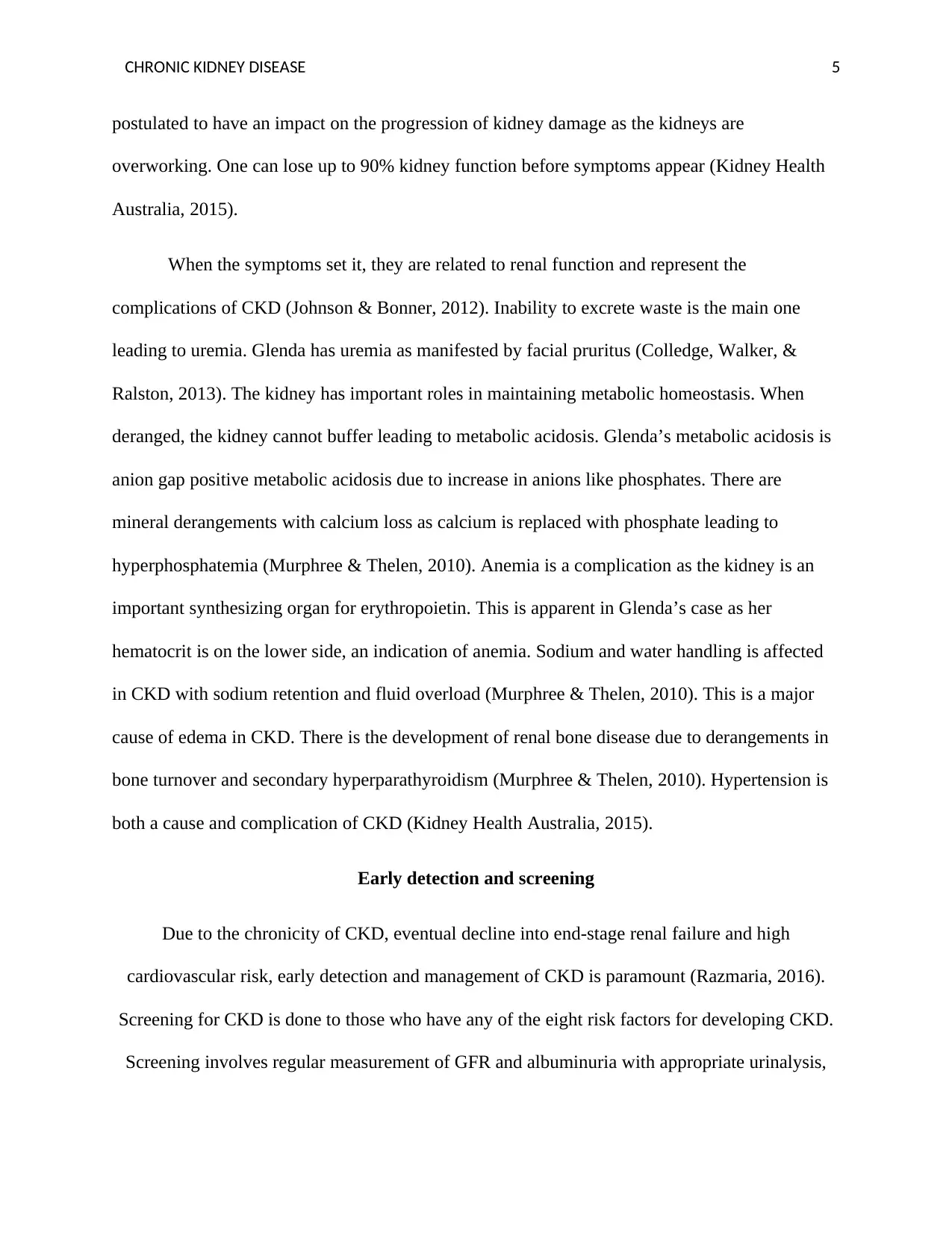
CHRONIC KIDNEY DISEASE 5
postulated to have an impact on the progression of kidney damage as the kidneys are
overworking. One can lose up to 90% kidney function before symptoms appear (Kidney Health
Australia, 2015).
When the symptoms set it, they are related to renal function and represent the
complications of CKD (Johnson & Bonner, 2012). Inability to excrete waste is the main one
leading to uremia. Glenda has uremia as manifested by facial pruritus (Colledge, Walker, &
Ralston, 2013). The kidney has important roles in maintaining metabolic homeostasis. When
deranged, the kidney cannot buffer leading to metabolic acidosis. Glenda’s metabolic acidosis is
anion gap positive metabolic acidosis due to increase in anions like phosphates. There are
mineral derangements with calcium loss as calcium is replaced with phosphate leading to
hyperphosphatemia (Murphree & Thelen, 2010). Anemia is a complication as the kidney is an
important synthesizing organ for erythropoietin. This is apparent in Glenda’s case as her
hematocrit is on the lower side, an indication of anemia. Sodium and water handling is affected
in CKD with sodium retention and fluid overload (Murphree & Thelen, 2010). This is a major
cause of edema in CKD. There is the development of renal bone disease due to derangements in
bone turnover and secondary hyperparathyroidism (Murphree & Thelen, 2010). Hypertension is
both a cause and complication of CKD (Kidney Health Australia, 2015).
Early detection and screening
Due to the chronicity of CKD, eventual decline into end-stage renal failure and high
cardiovascular risk, early detection and management of CKD is paramount (Razmaria, 2016).
Screening for CKD is done to those who have any of the eight risk factors for developing CKD.
Screening involves regular measurement of GFR and albuminuria with appropriate urinalysis,
postulated to have an impact on the progression of kidney damage as the kidneys are
overworking. One can lose up to 90% kidney function before symptoms appear (Kidney Health
Australia, 2015).
When the symptoms set it, they are related to renal function and represent the
complications of CKD (Johnson & Bonner, 2012). Inability to excrete waste is the main one
leading to uremia. Glenda has uremia as manifested by facial pruritus (Colledge, Walker, &
Ralston, 2013). The kidney has important roles in maintaining metabolic homeostasis. When
deranged, the kidney cannot buffer leading to metabolic acidosis. Glenda’s metabolic acidosis is
anion gap positive metabolic acidosis due to increase in anions like phosphates. There are
mineral derangements with calcium loss as calcium is replaced with phosphate leading to
hyperphosphatemia (Murphree & Thelen, 2010). Anemia is a complication as the kidney is an
important synthesizing organ for erythropoietin. This is apparent in Glenda’s case as her
hematocrit is on the lower side, an indication of anemia. Sodium and water handling is affected
in CKD with sodium retention and fluid overload (Murphree & Thelen, 2010). This is a major
cause of edema in CKD. There is the development of renal bone disease due to derangements in
bone turnover and secondary hyperparathyroidism (Murphree & Thelen, 2010). Hypertension is
both a cause and complication of CKD (Kidney Health Australia, 2015).
Early detection and screening
Due to the chronicity of CKD, eventual decline into end-stage renal failure and high
cardiovascular risk, early detection and management of CKD is paramount (Razmaria, 2016).
Screening for CKD is done to those who have any of the eight risk factors for developing CKD.
Screening involves regular measurement of GFR and albuminuria with appropriate urinalysis,
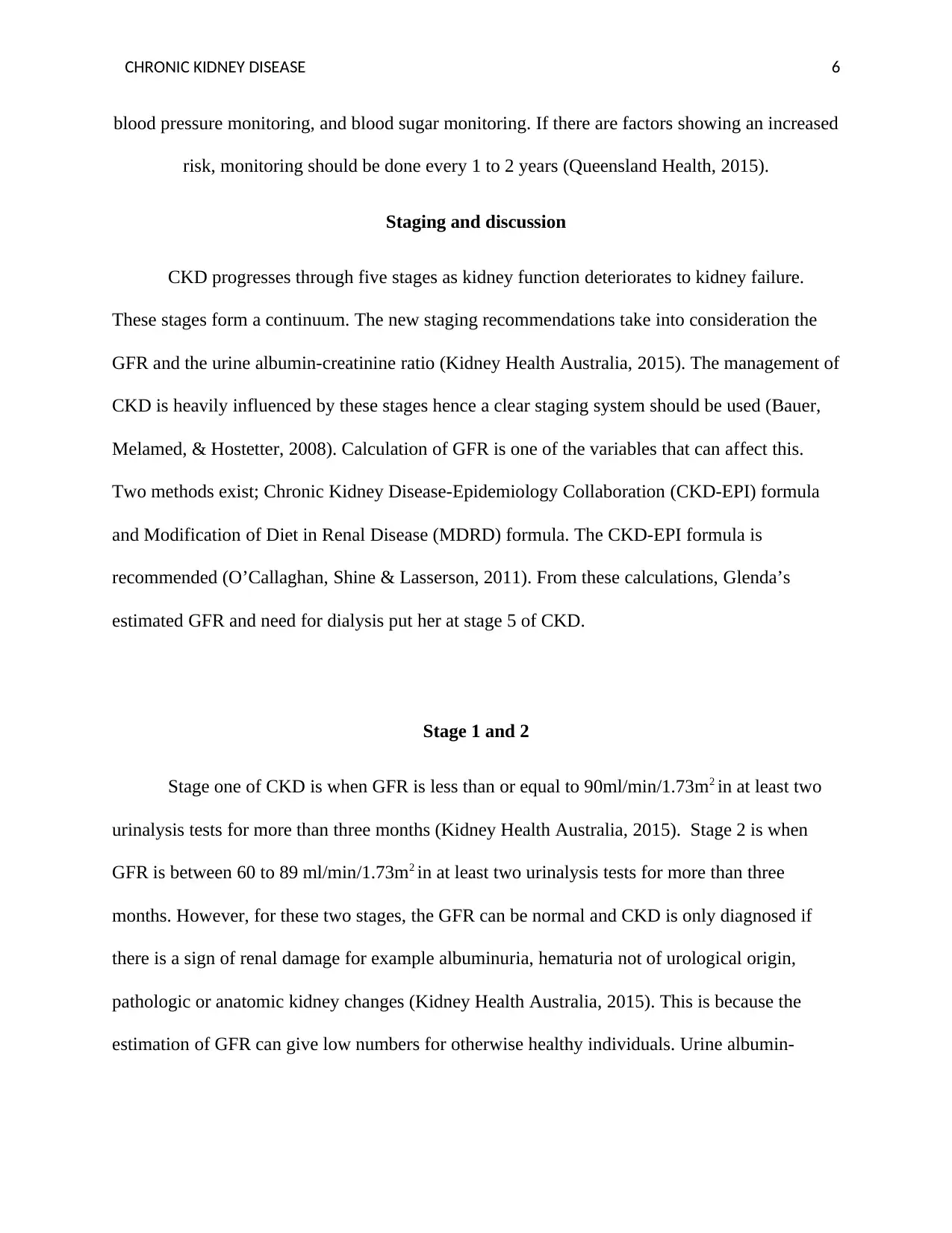
CHRONIC KIDNEY DISEASE 6
blood pressure monitoring, and blood sugar monitoring. If there are factors showing an increased
risk, monitoring should be done every 1 to 2 years (Queensland Health, 2015).
Staging and discussion
CKD progresses through five stages as kidney function deteriorates to kidney failure.
These stages form a continuum. The new staging recommendations take into consideration the
GFR and the urine albumin-creatinine ratio (Kidney Health Australia, 2015). The management of
CKD is heavily influenced by these stages hence a clear staging system should be used (Bauer,
Melamed, & Hostetter, 2008). Calculation of GFR is one of the variables that can affect this.
Two methods exist; Chronic Kidney Disease-Epidemiology Collaboration (CKD-EPI) formula
and Modification of Diet in Renal Disease (MDRD) formula. The CKD-EPI formula is
recommended (O’Callaghan, Shine & Lasserson, 2011). From these calculations, Glenda’s
estimated GFR and need for dialysis put her at stage 5 of CKD.
Stage 1 and 2
Stage one of CKD is when GFR is less than or equal to 90ml/min/1.73m2 in at least two
urinalysis tests for more than three months (Kidney Health Australia, 2015). Stage 2 is when
GFR is between 60 to 89 ml/min/1.73m2 in at least two urinalysis tests for more than three
months. However, for these two stages, the GFR can be normal and CKD is only diagnosed if
there is a sign of renal damage for example albuminuria, hematuria not of urological origin,
pathologic or anatomic kidney changes (Kidney Health Australia, 2015). This is because the
estimation of GFR can give low numbers for otherwise healthy individuals. Urine albumin-
blood pressure monitoring, and blood sugar monitoring. If there are factors showing an increased
risk, monitoring should be done every 1 to 2 years (Queensland Health, 2015).
Staging and discussion
CKD progresses through five stages as kidney function deteriorates to kidney failure.
These stages form a continuum. The new staging recommendations take into consideration the
GFR and the urine albumin-creatinine ratio (Kidney Health Australia, 2015). The management of
CKD is heavily influenced by these stages hence a clear staging system should be used (Bauer,
Melamed, & Hostetter, 2008). Calculation of GFR is one of the variables that can affect this.
Two methods exist; Chronic Kidney Disease-Epidemiology Collaboration (CKD-EPI) formula
and Modification of Diet in Renal Disease (MDRD) formula. The CKD-EPI formula is
recommended (O’Callaghan, Shine & Lasserson, 2011). From these calculations, Glenda’s
estimated GFR and need for dialysis put her at stage 5 of CKD.
Stage 1 and 2
Stage one of CKD is when GFR is less than or equal to 90ml/min/1.73m2 in at least two
urinalysis tests for more than three months (Kidney Health Australia, 2015). Stage 2 is when
GFR is between 60 to 89 ml/min/1.73m2 in at least two urinalysis tests for more than three
months. However, for these two stages, the GFR can be normal and CKD is only diagnosed if
there is a sign of renal damage for example albuminuria, hematuria not of urological origin,
pathologic or anatomic kidney changes (Kidney Health Australia, 2015). This is because the
estimation of GFR can give low numbers for otherwise healthy individuals. Urine albumin-

CHRONIC KIDNEY DISEASE 7
creatinine ratio (ACR) should be done to stratify the patient in categories of low, moderate or
high risk of progressive renal impairment (Kidney Health Australia, 2015; Glassock, 2010)
Management goals at these stages are aimed at slowing progression of kidney damage
and cardiovascular risk management (Castner, 2010). This stage can be treated in the primary
care setting but the bigger issue is assessing cardiovascular risk. CKD is a large risk for mortality
from cardiovascular causes and a patient is more likely to die from cardiovascular causes than
kidney failure (Johnson & Bonner, 2012).
Pointers of progressive kidney disease may include hematuria, rapidly worsening renal
function, albuminuria, family history of renal failure and hypertension (Castner, 2010). Long-
term monitoring of renal function, blood pressure, and proteinuria is indicated. Avoidance of
nephrotoxic drugs is also an important nursing consideration.
Lowering of cardiovascular risk starts with reducing the blood pressure. Angiotensin-
converting enzyme (ACE) inhibitors and Angiotensin receptor blockers (ARBS) are the first line
therapy for BP reduction in CKD and renal protection (Queensland Health, 2015). They decrease
the risk of end-stage kidney disease by up to 40 %. Lifestyle modifications should be
implemented including smoking cessation, appropriate nutrition change for example low sodium
and low-calorie diet, weight reduction, reducing alcohol intake and increasing physical activity
(Kidney Health Australia, 2015). Glycemic control is another measure. Lipid-lowering drugs can
be used to further lessen the risk. Glenda should have been advised on these modifications early.
She has three of the eight risk factors making these modifications crucial to her care.
Stage 3
creatinine ratio (ACR) should be done to stratify the patient in categories of low, moderate or
high risk of progressive renal impairment (Kidney Health Australia, 2015; Glassock, 2010)
Management goals at these stages are aimed at slowing progression of kidney damage
and cardiovascular risk management (Castner, 2010). This stage can be treated in the primary
care setting but the bigger issue is assessing cardiovascular risk. CKD is a large risk for mortality
from cardiovascular causes and a patient is more likely to die from cardiovascular causes than
kidney failure (Johnson & Bonner, 2012).
Pointers of progressive kidney disease may include hematuria, rapidly worsening renal
function, albuminuria, family history of renal failure and hypertension (Castner, 2010). Long-
term monitoring of renal function, blood pressure, and proteinuria is indicated. Avoidance of
nephrotoxic drugs is also an important nursing consideration.
Lowering of cardiovascular risk starts with reducing the blood pressure. Angiotensin-
converting enzyme (ACE) inhibitors and Angiotensin receptor blockers (ARBS) are the first line
therapy for BP reduction in CKD and renal protection (Queensland Health, 2015). They decrease
the risk of end-stage kidney disease by up to 40 %. Lifestyle modifications should be
implemented including smoking cessation, appropriate nutrition change for example low sodium
and low-calorie diet, weight reduction, reducing alcohol intake and increasing physical activity
(Kidney Health Australia, 2015). Glycemic control is another measure. Lipid-lowering drugs can
be used to further lessen the risk. Glenda should have been advised on these modifications early.
She has three of the eight risk factors making these modifications crucial to her care.
Stage 3
Paraphrase This Document
Need a fresh take? Get an instant paraphrase of this document with our AI Paraphraser
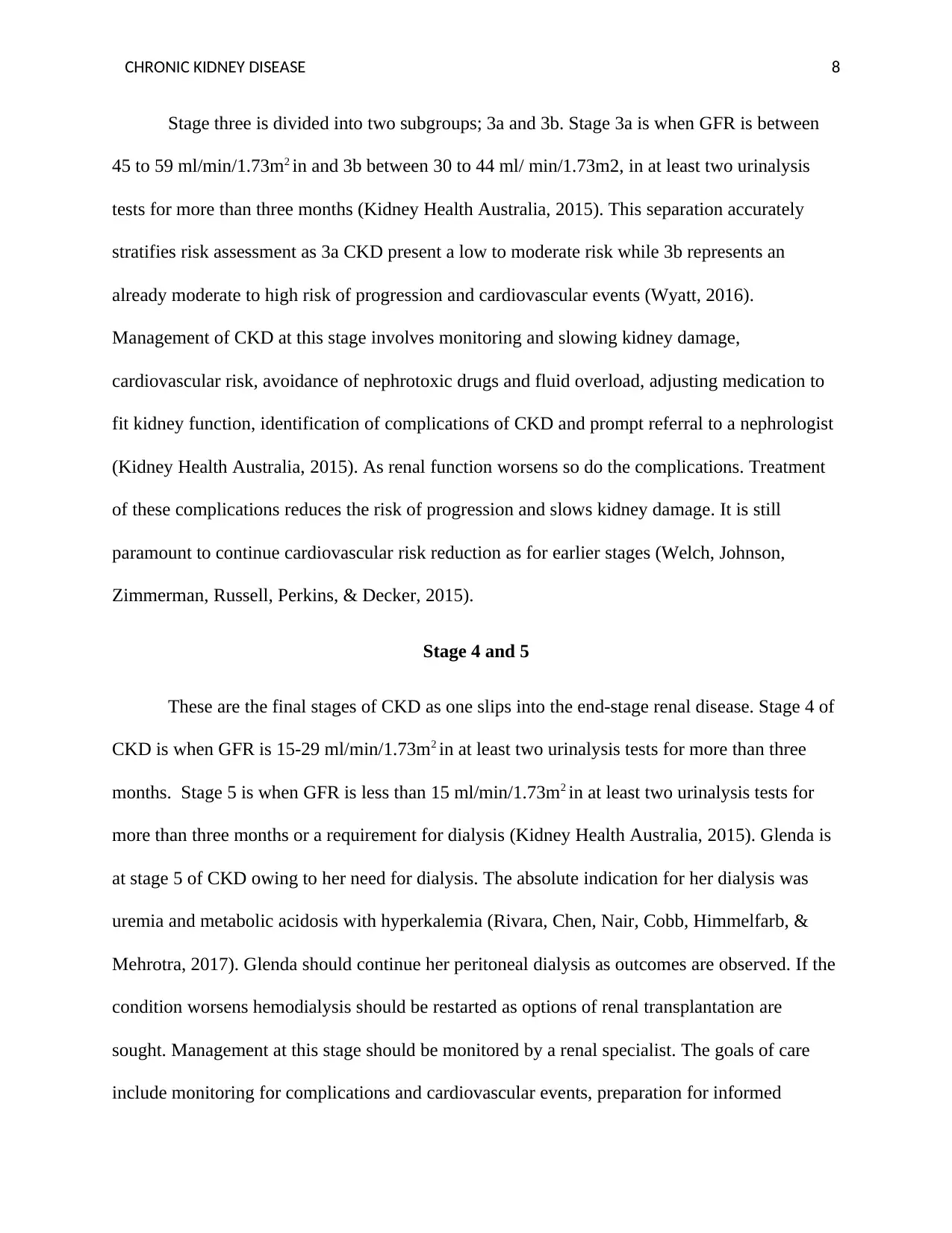
CHRONIC KIDNEY DISEASE 8
Stage three is divided into two subgroups; 3a and 3b. Stage 3a is when GFR is between
45 to 59 ml/min/1.73m2 in and 3b between 30 to 44 ml/ min/1.73m2, in at least two urinalysis
tests for more than three months (Kidney Health Australia, 2015). This separation accurately
stratifies risk assessment as 3a CKD present a low to moderate risk while 3b represents an
already moderate to high risk of progression and cardiovascular events (Wyatt, 2016).
Management of CKD at this stage involves monitoring and slowing kidney damage,
cardiovascular risk, avoidance of nephrotoxic drugs and fluid overload, adjusting medication to
fit kidney function, identification of complications of CKD and prompt referral to a nephrologist
(Kidney Health Australia, 2015). As renal function worsens so do the complications. Treatment
of these complications reduces the risk of progression and slows kidney damage. It is still
paramount to continue cardiovascular risk reduction as for earlier stages (Welch, Johnson,
Zimmerman, Russell, Perkins, & Decker, 2015).
Stage 4 and 5
These are the final stages of CKD as one slips into the end-stage renal disease. Stage 4 of
CKD is when GFR is 15-29 ml/min/1.73m2 in at least two urinalysis tests for more than three
months. Stage 5 is when GFR is less than 15 ml/min/1.73m2 in at least two urinalysis tests for
more than three months or a requirement for dialysis (Kidney Health Australia, 2015). Glenda is
at stage 5 of CKD owing to her need for dialysis. The absolute indication for her dialysis was
uremia and metabolic acidosis with hyperkalemia (Rivara, Chen, Nair, Cobb, Himmelfarb, &
Mehrotra, 2017). Glenda should continue her peritoneal dialysis as outcomes are observed. If the
condition worsens hemodialysis should be restarted as options of renal transplantation are
sought. Management at this stage should be monitored by a renal specialist. The goals of care
include monitoring for complications and cardiovascular events, preparation for informed
Stage three is divided into two subgroups; 3a and 3b. Stage 3a is when GFR is between
45 to 59 ml/min/1.73m2 in and 3b between 30 to 44 ml/ min/1.73m2, in at least two urinalysis
tests for more than three months (Kidney Health Australia, 2015). This separation accurately
stratifies risk assessment as 3a CKD present a low to moderate risk while 3b represents an
already moderate to high risk of progression and cardiovascular events (Wyatt, 2016).
Management of CKD at this stage involves monitoring and slowing kidney damage,
cardiovascular risk, avoidance of nephrotoxic drugs and fluid overload, adjusting medication to
fit kidney function, identification of complications of CKD and prompt referral to a nephrologist
(Kidney Health Australia, 2015). As renal function worsens so do the complications. Treatment
of these complications reduces the risk of progression and slows kidney damage. It is still
paramount to continue cardiovascular risk reduction as for earlier stages (Welch, Johnson,
Zimmerman, Russell, Perkins, & Decker, 2015).
Stage 4 and 5
These are the final stages of CKD as one slips into the end-stage renal disease. Stage 4 of
CKD is when GFR is 15-29 ml/min/1.73m2 in at least two urinalysis tests for more than three
months. Stage 5 is when GFR is less than 15 ml/min/1.73m2 in at least two urinalysis tests for
more than three months or a requirement for dialysis (Kidney Health Australia, 2015). Glenda is
at stage 5 of CKD owing to her need for dialysis. The absolute indication for her dialysis was
uremia and metabolic acidosis with hyperkalemia (Rivara, Chen, Nair, Cobb, Himmelfarb, &
Mehrotra, 2017). Glenda should continue her peritoneal dialysis as outcomes are observed. If the
condition worsens hemodialysis should be restarted as options of renal transplantation are
sought. Management at this stage should be monitored by a renal specialist. The goals of care
include monitoring for complications and cardiovascular events, preparation for informed
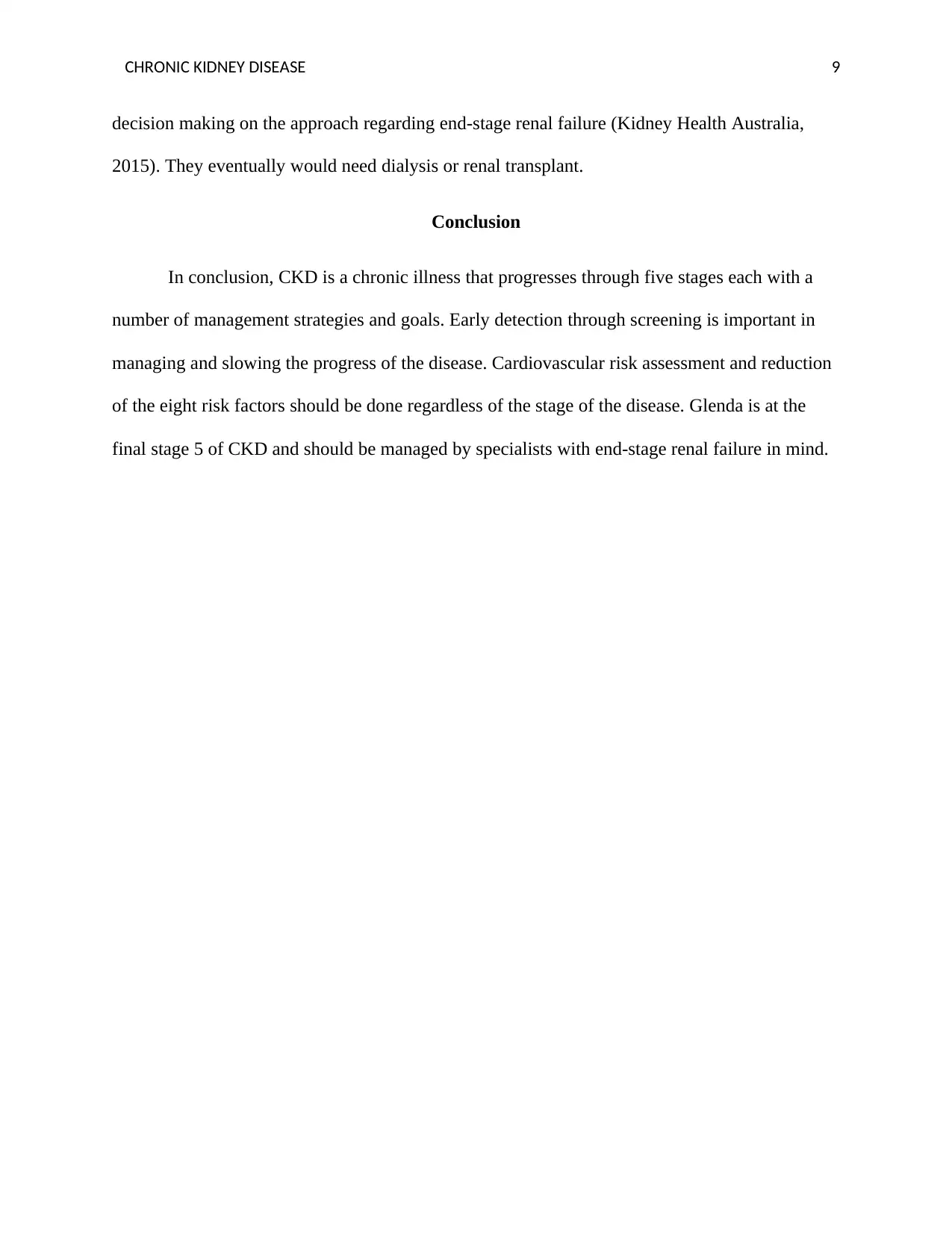
CHRONIC KIDNEY DISEASE 9
decision making on the approach regarding end-stage renal failure (Kidney Health Australia,
2015). They eventually would need dialysis or renal transplant.
Conclusion
In conclusion, CKD is a chronic illness that progresses through five stages each with a
number of management strategies and goals. Early detection through screening is important in
managing and slowing the progress of the disease. Cardiovascular risk assessment and reduction
of the eight risk factors should be done regardless of the stage of the disease. Glenda is at the
final stage 5 of CKD and should be managed by specialists with end-stage renal failure in mind.
decision making on the approach regarding end-stage renal failure (Kidney Health Australia,
2015). They eventually would need dialysis or renal transplant.
Conclusion
In conclusion, CKD is a chronic illness that progresses through five stages each with a
number of management strategies and goals. Early detection through screening is important in
managing and slowing the progress of the disease. Cardiovascular risk assessment and reduction
of the eight risk factors should be done regardless of the stage of the disease. Glenda is at the
final stage 5 of CKD and should be managed by specialists with end-stage renal failure in mind.
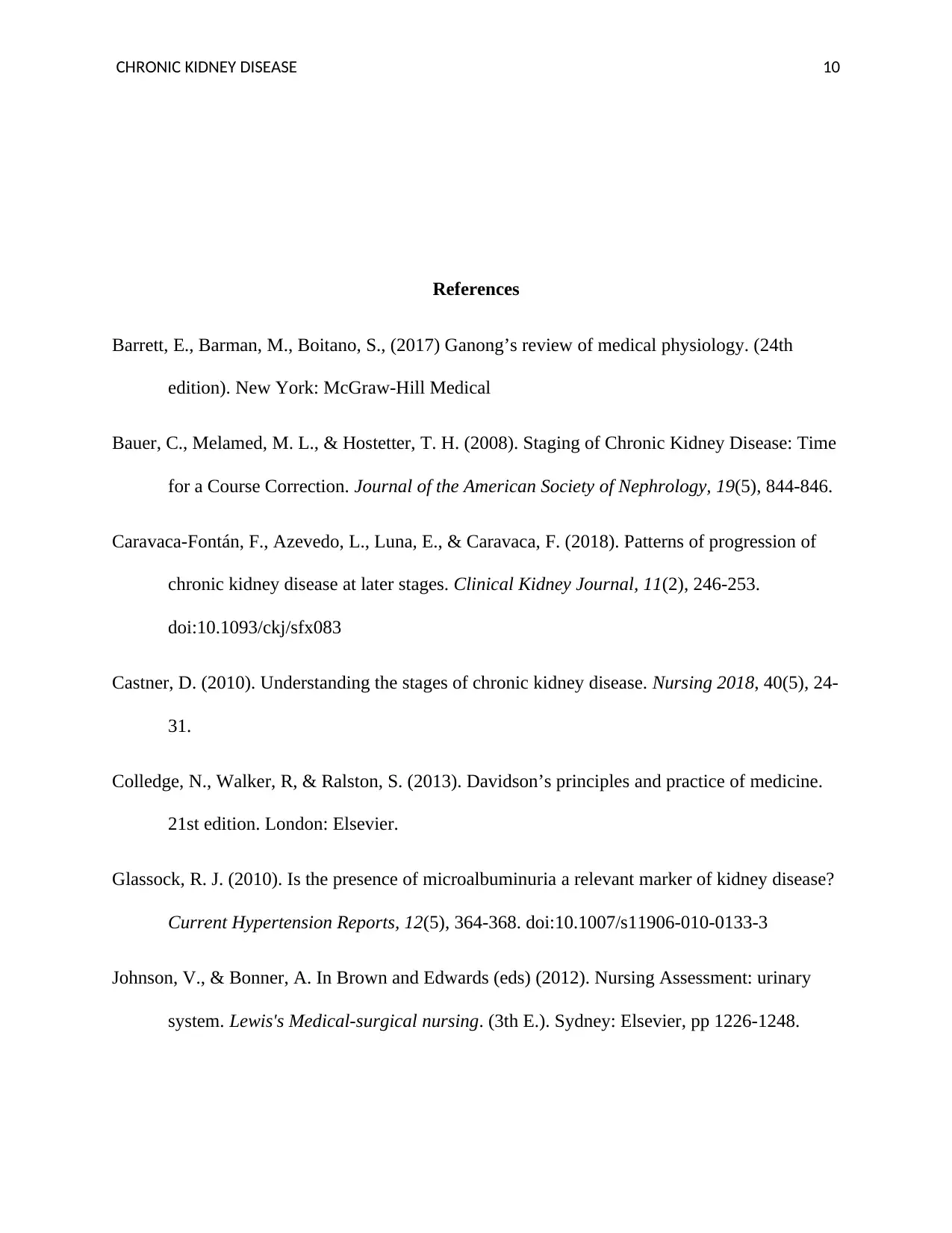
CHRONIC KIDNEY DISEASE 10
References
Barrett, E., Barman, M., Boitano, S., (2017) Ganong’s review of medical physiology. (24th
edition). New York: McGraw-Hill Medical
Bauer, C., Melamed, M. L., & Hostetter, T. H. (2008). Staging of Chronic Kidney Disease: Time
for a Course Correction. Journal of the American Society of Nephrology, 19(5), 844-846.
Caravaca-Fontán, F., Azevedo, L., Luna, E., & Caravaca, F. (2018). Patterns of progression of
chronic kidney disease at later stages. Clinical Kidney Journal, 11(2), 246-253.
doi:10.1093/ckj/sfx083
Castner, D. (2010). Understanding the stages of chronic kidney disease. Nursing 2018, 40(5), 24-
31.
Colledge, N., Walker, R, & Ralston, S. (2013). Davidson’s principles and practice of medicine.
21st edition. London: Elsevier.
Glassock, R. J. (2010). Is the presence of microalbuminuria a relevant marker of kidney disease?
Current Hypertension Reports, 12(5), 364-368. doi:10.1007/s11906-010-0133-3
Johnson, V., & Bonner, A. In Brown and Edwards (eds) (2012). Nursing Assessment: urinary
system. Lewis's Medical-surgical nursing. (3th E.). Sydney: Elsevier, pp 1226-1248.
References
Barrett, E., Barman, M., Boitano, S., (2017) Ganong’s review of medical physiology. (24th
edition). New York: McGraw-Hill Medical
Bauer, C., Melamed, M. L., & Hostetter, T. H. (2008). Staging of Chronic Kidney Disease: Time
for a Course Correction. Journal of the American Society of Nephrology, 19(5), 844-846.
Caravaca-Fontán, F., Azevedo, L., Luna, E., & Caravaca, F. (2018). Patterns of progression of
chronic kidney disease at later stages. Clinical Kidney Journal, 11(2), 246-253.
doi:10.1093/ckj/sfx083
Castner, D. (2010). Understanding the stages of chronic kidney disease. Nursing 2018, 40(5), 24-
31.
Colledge, N., Walker, R, & Ralston, S. (2013). Davidson’s principles and practice of medicine.
21st edition. London: Elsevier.
Glassock, R. J. (2010). Is the presence of microalbuminuria a relevant marker of kidney disease?
Current Hypertension Reports, 12(5), 364-368. doi:10.1007/s11906-010-0133-3
Johnson, V., & Bonner, A. In Brown and Edwards (eds) (2012). Nursing Assessment: urinary
system. Lewis's Medical-surgical nursing. (3th E.). Sydney: Elsevier, pp 1226-1248.
Secure Best Marks with AI Grader
Need help grading? Try our AI Grader for instant feedback on your assignments.
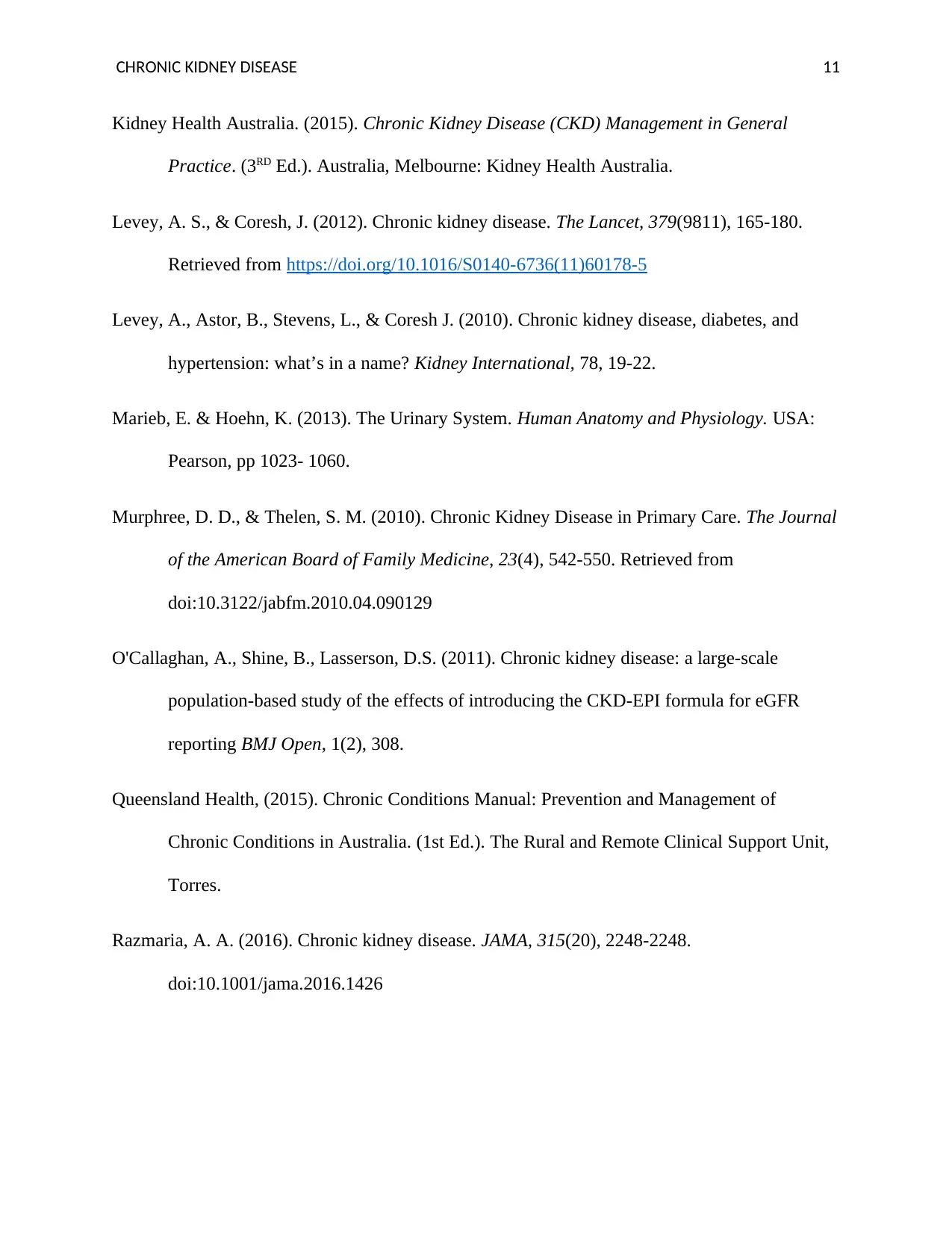
CHRONIC KIDNEY DISEASE 11
Kidney Health Australia. (2015). Chronic Kidney Disease (CKD) Management in General
Practice. (3RD Ed.). Australia, Melbourne: Kidney Health Australia.
Levey, A. S., & Coresh, J. (2012). Chronic kidney disease. The Lancet, 379(9811), 165-180.
Retrieved from https://doi.org/10.1016/S0140-6736(11)60178-5
Levey, A., Astor, B., Stevens, L., & Coresh J. (2010). Chronic kidney disease, diabetes, and
hypertension: what’s in a name? Kidney International, 78, 19-22.
Marieb, E. & Hoehn, K. (2013). The Urinary System. Human Anatomy and Physiology. USA:
Pearson, pp 1023- 1060.
Murphree, D. D., & Thelen, S. M. (2010). Chronic Kidney Disease in Primary Care. The Journal
of the American Board of Family Medicine, 23(4), 542-550. Retrieved from
doi:10.3122/jabfm.2010.04.090129
O'Callaghan, A., Shine, B., Lasserson, D.S. (2011). Chronic kidney disease: a large-scale
population-based study of the effects of introducing the CKD-EPI formula for eGFR
reporting BMJ Open, 1(2), 308.
Queensland Health, (2015). Chronic Conditions Manual: Prevention and Management of
Chronic Conditions in Australia. (1st Ed.). The Rural and Remote Clinical Support Unit,
Torres.
Razmaria, A. A. (2016). Chronic kidney disease. JAMA, 315(20), 2248-2248.
doi:10.1001/jama.2016.1426
Kidney Health Australia. (2015). Chronic Kidney Disease (CKD) Management in General
Practice. (3RD Ed.). Australia, Melbourne: Kidney Health Australia.
Levey, A. S., & Coresh, J. (2012). Chronic kidney disease. The Lancet, 379(9811), 165-180.
Retrieved from https://doi.org/10.1016/S0140-6736(11)60178-5
Levey, A., Astor, B., Stevens, L., & Coresh J. (2010). Chronic kidney disease, diabetes, and
hypertension: what’s in a name? Kidney International, 78, 19-22.
Marieb, E. & Hoehn, K. (2013). The Urinary System. Human Anatomy and Physiology. USA:
Pearson, pp 1023- 1060.
Murphree, D. D., & Thelen, S. M. (2010). Chronic Kidney Disease in Primary Care. The Journal
of the American Board of Family Medicine, 23(4), 542-550. Retrieved from
doi:10.3122/jabfm.2010.04.090129
O'Callaghan, A., Shine, B., Lasserson, D.S. (2011). Chronic kidney disease: a large-scale
population-based study of the effects of introducing the CKD-EPI formula for eGFR
reporting BMJ Open, 1(2), 308.
Queensland Health, (2015). Chronic Conditions Manual: Prevention and Management of
Chronic Conditions in Australia. (1st Ed.). The Rural and Remote Clinical Support Unit,
Torres.
Razmaria, A. A. (2016). Chronic kidney disease. JAMA, 315(20), 2248-2248.
doi:10.1001/jama.2016.1426
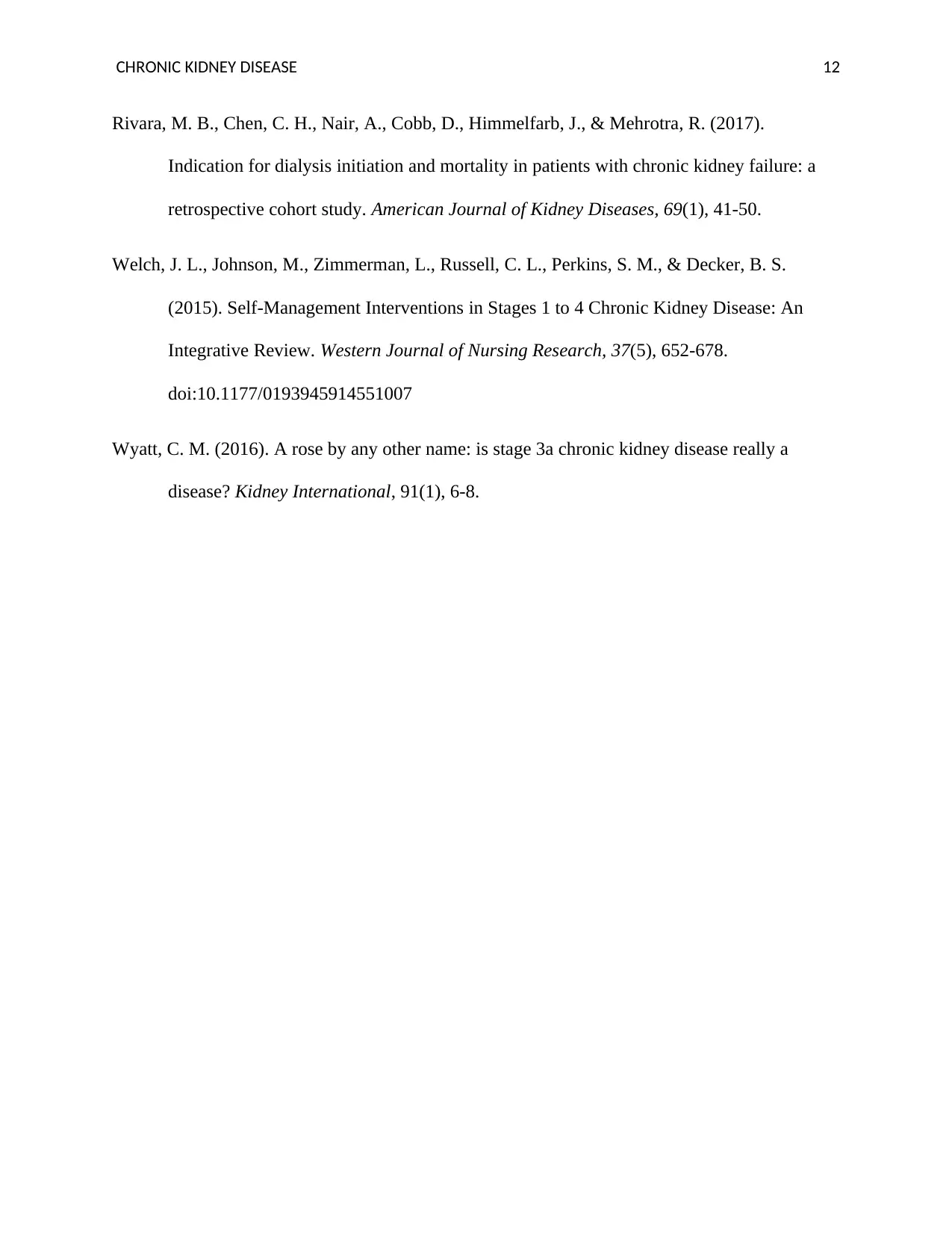
CHRONIC KIDNEY DISEASE 12
Rivara, M. B., Chen, C. H., Nair, A., Cobb, D., Himmelfarb, J., & Mehrotra, R. (2017).
Indication for dialysis initiation and mortality in patients with chronic kidney failure: a
retrospective cohort study. American Journal of Kidney Diseases, 69(1), 41-50.
Welch, J. L., Johnson, M., Zimmerman, L., Russell, C. L., Perkins, S. M., & Decker, B. S.
(2015). Self-Management Interventions in Stages 1 to 4 Chronic Kidney Disease: An
Integrative Review. Western Journal of Nursing Research, 37(5), 652-678.
doi:10.1177/0193945914551007
Wyatt, C. M. (2016). A rose by any other name: is stage 3a chronic kidney disease really a
disease? Kidney International, 91(1), 6-8.
Rivara, M. B., Chen, C. H., Nair, A., Cobb, D., Himmelfarb, J., & Mehrotra, R. (2017).
Indication for dialysis initiation and mortality in patients with chronic kidney failure: a
retrospective cohort study. American Journal of Kidney Diseases, 69(1), 41-50.
Welch, J. L., Johnson, M., Zimmerman, L., Russell, C. L., Perkins, S. M., & Decker, B. S.
(2015). Self-Management Interventions in Stages 1 to 4 Chronic Kidney Disease: An
Integrative Review. Western Journal of Nursing Research, 37(5), 652-678.
doi:10.1177/0193945914551007
Wyatt, C. M. (2016). A rose by any other name: is stage 3a chronic kidney disease really a
disease? Kidney International, 91(1), 6-8.
1 out of 12
Your All-in-One AI-Powered Toolkit for Academic Success.
+13062052269
info@desklib.com
Available 24*7 on WhatsApp / Email
![[object Object]](/_next/static/media/star-bottom.7253800d.svg)
Unlock your academic potential
© 2024 | Zucol Services PVT LTD | All rights reserved.